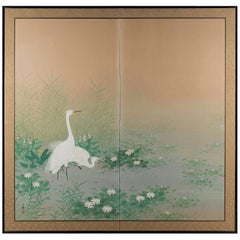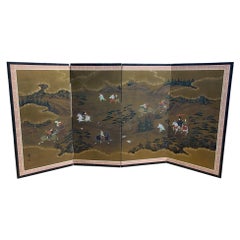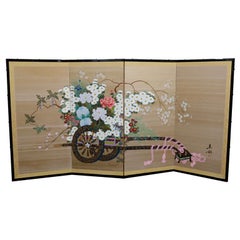Taisho Home Accents
3
to
2
3
3
3
919
526
456
184
111
88
68
61
54
48
42
41
40
32
31
20
15
10
3
3
2
2
1
1
1
3
3
3
Style: Taisho
Japanese Antique Pair Large Red And Gilt Elephant And Lion Temple Benches, 1925
Located in South Burlington, VT
Here's a wonderful find from our acquisitions trip to Japan.
We were fortunate to find this Art Deco period pair (2) matching hand-carved, hand red lacquered and gilt embellished temple wooden benches. The white elephant bench and matching shi-shi komainu temple lion both originally came from a temple near Kobe. Quite sturdy, they may have been entry sitting or shoe changing benches...
Category
Early 20th Century Japanese Taisho Home Accents
Materials
Textile, Wood, Lacquer
"Egrets Amongst Lotuses" Japanese Paper Byobu Screen, c. 1920
Located in Chicago, IL
Everything about "Egrets Amongst Lotuses" is timeless and delicate, particularly the fine paper, soft colors, and detailed brushstrokes. The painting is signed Kyokata and dates to t...
Category
Early 20th Century Japanese Taisho Home Accents
Materials
Silk, Wood, Paper
Vintage Japanese Two-Panel Screen, Taisho Period, Early 20th Century
Located in Prahran, Victoria
Japanese two-panel screen, study of an Okinawan mother and child, Taisho period early 20th century, dating from the 1920's. Signed by Matsumura Baiso, (1884-1935). Baiso was a studen...
Category
Early 20th Century Japanese Taisho Home Accents
Related Items
Japanese Asian Signed Four-Panel Folding Byobu Screen Landscape Hunting Scene
Located in Studio City, CA
A gorgeous four-panel Japanese Byobu folding screen depicting a hunting scene with various warriors and animals spread across a vast, mountainous ...
Category
Early 20th Century Japanese Taisho Home Accents
Materials
Gold Leaf
Vintage Japanese "Flower Cart" Folding Screen
Located in New York, NY
A traditional style Japanese four panel folding screen depicting a flower cart full of red and white flowers.
10198
Category
20th Century Japanese Taisho Home Accents
Japanese 4 Panel Folding Screen with Eight Samurai
Located in New York, NY
A Japanese folding screen with four panels depicting eight seated samurai in a structure surrounded by trees on a gold background.
10197
Category
19th Century Japanese Antique Taisho Home Accents
Materials
Paper
Japanese Asian Four-Panel Folding Byobu Showa Hunting Hawks Falcons Bird Screen
Located in Studio City, CA
A beautiful and engaging four-panel Japanese Byobu folding screen depicting three distinct tethered and tamed hunting birds of prey - hawks or falcons (Takagari) - sitting upon their...
Category
Mid-20th Century Japanese Taisho Home Accents
Materials
Gold Leaf
H 36 in W 70.5 in D 0.6 in
Japanese Wood Gilt Lacquer Buddha Buddhist Temple Traveling Zushi Shrine Altar
Located in Studio City, CA
A wonderful Japanese Buddhist portable traveling zushi shrine altar with Amida Buddha (Amitabha) concealed inside the folded wood doors.
This work dat...
Category
Early 20th Century Japanese Taisho Home Accents
Materials
Metal, Gold Leaf
H 8.25 in W 4 in D 3 in
20th Century Black Chinese Lacquered Wood Screen, Vintage Room Divider
Located in West Palm Beach, FL
A black, vintage Chinese screen made of hand crafted lacquered wood, in good condition. The large, detailed Chinoiserie style room divider is co...
Category
Mid-20th Century Chinese Taisho Home Accents
Materials
Metal, Brass
No Reserve
H 96.5 in W 144 in D 3 in
1950s Japanese Asian Four-Panel Byobu Showa Folding Screen of Flowering Lotus
Located in Germantown, MD
A 1950s Japanese Asian four-panel Byobu Showa folding screen of flowering lotus in good vintage condition.
Category
Mid-20th Century Japanese Taisho Home Accents
Materials
Brass
Japanese Edo Period Two-Panel Screen
Located in Stamford, CT
A Japanese Edo Period two panel folding screen with white and brown hawks of ink and color on paper.
Category
Mid-19th Century Japanese Antique Taisho Home Accents
Materials
Paper
20th Century French Two Panel Screen
Located in Nashville, TN
Two panel folding screen with oil paintings depicting mythological male figures. Back of screen is upholstered in silk damask. Brass nailhead trim. Fabric hinges.
Category
Early 20th Century French Taisho Home Accents
Materials
Silk, Damask
A pair of 19th Century carved Foo temple dogs or Chinese guardian Lions
Located in London, GB
Chinese guardian lions, or imperial guardian lions, are a traditional Chinese architectural ornament. Typically made of stone, they are also known as stone lions or shishi (石獅; shíshī). They are known in colloquial English as lion dogs or foo dogs / fu dogs. The concept, which originated and became popular in Chinese Buddhism, features a pair of highly stylized lions—often one male with a ball and one female with a cub—which were thought to protect the building from harmful spiritual influences and harmful people that might be a threat. Used in imperial Chinese palaces and tombs, the lions subsequently spread to other parts of Asia including Japan (see komainu), Korea, Philippines, Tibet, Thailand, Myanmar, Vietnam, Sri Lanka, Nepal, Cambodia, Laos, and Malaysia.
There has been extensive interaction between Chinese mythology and Confucianism, Taoism, and Buddhism. Elements of pre-Han dynasty mythology such as those in Classic of Mountains and Seas were adapted into these belief systems as they developed (in the case of Taoism), or were assimilated into Chinese culture (in the case of Buddhism). Elements from the teachings and beliefs of these systems became incorporated into Chinese mythology. For example, the Taoist belief of a spiritual Paradise became incorporated into mythology as the place where immortals and deities used to dwell. Sometimes mythological and religious ideas have become widespread across China's many regions and diverse ethnic societies. In other cases, beliefs are more limited to certain social groups, for example, the veneration of white stones by the Qiang. One mythological theme that has a long history and many variations involves a shamanic world view, for example in the cases of Mongolian shamanism among the Mongols, Hmong shamanism among the Miao people, and the shamanic beliefs of the Qing dynasty from 1643 to 1912, derived from the Manchus. Politically, mythology was often used to legitimize the dynasties of China, with the founding house of a dynasty claiming a divine descent.
Mythology and philosophy.
Further information: Chinese philosophy
True mythology is distinguished from philosophical treatises and theories. Elaborations on the Wu Xing are not really part of mythology, although belief in five elements could appear. The Hundred Schools of Thought is a phrase suggesting the diversity of philosophical thought that developed during the Warring States of China. Then, and subsequently, philosophical movements had a complicated relationship with mythology. However, as far as they influence or are influenced by mythology, divides the philosophical camps into two rough halves, a Liberal group and a Conservative group. The liberal group being associated with the idea of individuality and change, for example as seen in the mythology of divination in China, such as the mythology of the dragon horse that delivered the eight bagua diagrams to Fu Xi, and methods of individual empowerment as seen in the Yi Jing (Book of Changes). The Liberal tendency is towards individual freedom, Daoism, and Nature. The relationship of the Conservative philosophies to mythology is seen in the legendary Nine Tripod Cauldrons, mythology about the emperors and central bureaucratic governance, Confucianism, written histories, ceremonial observances, subordination of the individual to the social groups of family and state, and a fixation on stability and enduring institutions. The distinction between the Liberal and Conservative is very general, but important in Chinese thought. Contradictions can be found in the details, however these are often traditional, such as the embrace by Confucius of the philosophical aspects of the Yi Jing, and the back-and-forth about the Mandate of Heaven wherein one dynasty ends and another begins based according to accounts (some of heavily mythological) where the Way of Heaven results in change, but then a new ethical stable dynasty becomes established. Examples of this include the stories of Yi Yin, Tang of Shang and Jie of Xia or the similar fantastic stories around Duke of Zhou and King Zhou of Shang.
Mythology exists in relationship with other aspects of society and culture, such as ritual. Various rituals are explained by mythology. For example, the ritual burning of mortuary banknotes (Hell Money), lighting fireworks, and so on.
A good example of the relationship of Chinese mythology and ritual is the Yubu, also known as the Steps or Paces of Yu. During the course of his activities in controlling the Great Flood, Yu was supposed to have so fatigued himself that he lost all the hair from his legs and developed a serious limp. Daoist practitioners sometimes incorporate a curiously choreographed pedal locomotion into various rituals. Mythology and practice, one explains the other: in these rituals, the sacred time of Yu merges with the sacral practice of the present.
Various ideas about the nature of the earth, the universe, and their relationship to each other have historically existed as either a background or a focus of mythologies. One typical view is of a square earth separated from a round sky by sky pillars (mountains, trees, or undefined). Above the sky is the realm of Heaven, often viewed of as a vast area, with many inhabitants. Often the heavenly inhabitants are thought to be of an "as above so below" nature, their lives and social arrangements being parallel to those on earth, with a hierarchical government run by a supreme emperor, many palaces and lesser dwellings, a vast bureaucracy of many functions, clerks, guards, and servants. Below was a vast under ground land, also known as Diyu, Yellow Springs, Hell, and other terms. As time progressed, the idea of an underground land in which the souls of the departed were punished for their misdeeds during life became explicit, related to developments in Daoism and Buddhism. The underground world also came to be conceived of as inhabited by a vast bureaucracy, with kings, judges, torturers, conductors of souls, minor bureaucrats, recording secretaries, similar to the structure of society in the Middle Kingdom (earthly China).
Chinese temple Dogs...
Category
1860s Chinese Antique Taisho Home Accents
Materials
Hardwood
H 11.42 in W 20.48 in D 7.49 in
Temple Lion Jade Sculpture
Located in Roma, IT
Chinese jade archaic style "Temple lion" sculpture.
Jade, probably 18th Century.
5 x 20 cm.
Good conditions
Chinese guardian lions, or imperial guardian lions, are a traditional ...
Category
Late 18th Century Chinese Antique Taisho Home Accents
Materials
Jade
Thai Siam Khmer Bronze Gilt Singha Imperial Lion Foo Dog Temple Sculpture
Located in Studio City, CA
A beautiful Thai or Khmer bronze verdigris and golden parcel-gilt Imperial guardian temple Singha lion/dragon/foo dog. This piece has a wonderful patina and heft to it.
Likely mi...
Category
20th Century Thai Taisho Home Accents
Materials
Metal, Bronze
Previously Available Items
Japanese Folding Screen with Moon and Rabbit Drawn on Cloth/Old Partition/20th
Located in Sammu-shi, Chiba
This is an old Japanese folding screen.
It is an item made by dyeing cotton cloth instead of drawing directly on paper or silk.
The moon and rabbits are represented.
The moon and ...
Category
Mid-20th Century Japanese Taisho Home Accents
Materials
Cotton
H 26.42 in W 66.54 in D 0.71 in
Japanese Old Small Bamboo Bird Cage / Carefully Crafted Luxury Bird Cage
Located in Sammu-shi, Chiba
A birdcage built from Japanese bamboo.
The base and outer box are made of cedar.
It is used when keeping small birds such as white-eye.
There are two types of outer box lids.
I...
Category
Mid-20th Century Japanese Taisho Home Accents
Materials
Cedar, Bamboo
H 8.67 in W 6.89 in D 13.19 in
Japanese Antique Set Two Silk & Bamboo Blinds or Screens "Sudare"
Located in South Burlington, VT
Japan, a fine set of two (2) antique silk and bamboo sudare- Japanese rolled screens or blinds complete with original incised metal hangers and pretty silk bows. Fine condition. Rolled for easy installation and display.
Engraved metal hangers are 4 inches high and their opening is 2.5 inches. These may be removed for installation.
Dimensions: Each is 26 inches wide and 66.75 inches in length
The beautiful high quality blue and gold silk used in their construction is lovely. The cords are in tact. The metal hangers in perfect gently used condition.
The wavy bamboo sections you may view are natural and original to their construction and ensemble.
Their superb bamboo craftsmanship allows air or sunlight to enter while in down mode.
Good opportunity as complete traditional sets of two...
Category
Early 20th Century Japanese Taisho Home Accents
Materials
Silk, Bamboo
Japanese Antique Set Three Silk & Bamboo Blinds or Screens "Sudare" Fine Quality
Located in South Burlington, VT
Japan, a fine set of three (3) antique silk and bamboo sudare- one full length and two valences sized. These Japanese rolled screens or blinds come complete with original incised metal hanger on the full length one and pretty silk brocade and bows on all. Fine condition. Rolled for easy installation and display.
Engraved metal hanger on full length sudare is 4 inches high and their opening is 2.5 inches. This may be removed for installation.
Dimensions:
Full length example is 34.5 inches wide and 67.5 inches in length
Two valences each 34.5 inches wide and 11.25 inches in length
The beautiful high quality blue and gold silk used in their construction is lovely. The cords are intact. The metal hanger is in perfect gently used condition.
The wavy bamboo sections you may view are natural and original to their construction and ensemble.
Their superb bamboo craftsmanship allows air or sunlight to enter while in down mode.
Good opportunity as complete traditional sets of two...
Category
Early 20th Century Japanese Taisho Home Accents
Materials
Silk, Bamboo
H 67.5 in W 34.5 in D 4 in
Japanese Antique Set Four Fine Natural Shoji Bamboo Doors Screens, Moon Horizon
Located in South Burlington, VT
Japan, a fine set of four antique shoji natural bamboo lacquered doors or screens recently acquired from a Japanese private collector. The hand carved bo...
Category
Early 20th Century Japanese Taisho Home Accents
Materials
Bamboo, Wood
H 69.5 in W 26.25 in D 1.12 in
Japanese Taisho Period Byobu Screen with Noh Scenes
Located in Rio Vista, CA
Large Japanese two-panel Taisho period Byobu screen featuring colorful Noh scenes from a narrative play. Produced with handmade mulberry paper with rich texture and fiber. The screen...
Category
20th Century Japanese Taisho Home Accents
Materials
Wood, Paper
Japanese Antique Set Five Silk & Bamboo Blinds or Screens Sudare, Best in Class
Located in South Burlington, VT
Japan, a fine set of five antique silk and bamboo sudare- Japanese rolled screens or blinds complete with original incised metal hangers and pretty silk bows. Fine condition. Rolled ...
Category
Early 20th Century Japanese Taisho Home Accents
Materials
Paper
H 67 in W 34.5 in D 4 in
Japanese Antique Silk Painting Gaku White Nesting Doves and Moon Shapes Dwelling
Located in South Burlington, VT
FEBRUARY SALE - NOW SAVE 25% AND MORE
Japan a simple antique Painting -Gaku-, on silk, of a pair of white peace doves rendered against multiple golden brown moon shapes, perhaps an ...
Category
Early 20th Century Japanese Taisho Home Accents
Materials
Silk
H 13 in W 39.5 in D 0.75 in
Japanese Antique Pair Hand-Carved Elephant & Shi-Shi Temple Benches 1925
Located in South Burlington, VT
Here's a wonderful find from our most recent acquisitions trip to Japan.
We were fortunate and excited to find this Art Deco period pair (2) matching hand-carved, hand lacquered red and gilt embellished temple wooden benches. The white elephant bench...
Category
Early 20th Century Japanese Taisho Home Accents
Materials
Wood, Giltwood, Lacquer
Japan Two Antique Hand-Painted Gold Mist Birds, Maples Flowering Tree Paintings
Located in South Burlington, VT
Here's a Japanese antique pair of attractive hand-painted gold gilt mist Birds, maples and flowering plum tree, thin Fusima door panels that make stunning tabletop or wall art.
Each...
Category
Early 20th Century Japanese Taisho Home Accents
Materials
Silk, Wood
H 11.5 in W 36.5 in D 0.5 in
Taisho home accents for sale on 1stDibs.
Find a broad range of unique Taisho home accents for sale on 1stDibs. Many of these items were first offered in the Early 20th Century, but contemporary artisans have continued to produce works inspired by this style. If you’re looking to add vintage home accents created in this style to your space, the works available on 1stDibs include asian art and furniture, more furniture and collectibles and other home furnishings, frequently crafted with wood, fabric and other materials. If you’re shopping for used Taisho home accents made in a specific country, there are Asia, East Asia, and Japan pieces for sale on 1stDibs. It’s true that these talented designers have at times inspired knockoffs, but our experienced specialists have partnered with only top vetted sellers to offer authentic pieces that come with a buyer protection guarantee. Prices for home accents differ depending upon multiple factors, including designer, materials, construction methods, condition and provenance. On 1stDibs, the price for these items starts at $5,880 and tops out at $18,500 while the average work can sell for $18,000.
Recently Viewed
View AllMore Ways To Browse
Large Antique Steamer
Louis Vuitton 1890
Louis Vuitton Et
1890 Louis Vuitton
Treasure Trunk
Vintage Metal Trunk
Antique German Trunks
German Trunks Antique
Goyard Steamer Trunk
Antique Brown Leather Suitcase
Vintage Louis Vuitton Wardrobe Trunk
Vintage Luggage Set
1800 Antique Trunks
Pair Antique Trunks
High End Louis Vuitton
Trunk With Wheels
Courrier Trunk
Lv Case





